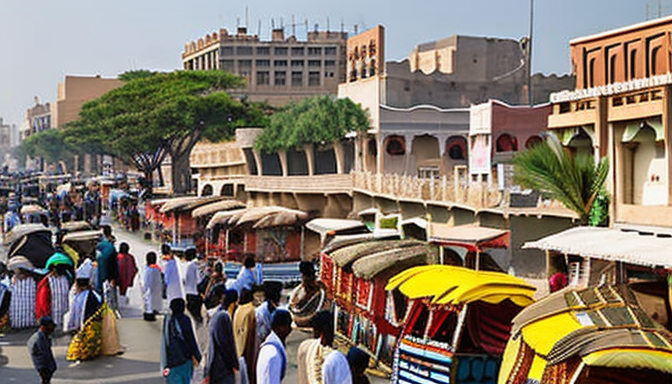Karachi, a city bursting with life and diversity, wears its colonial history like a badge. The British era left a mark that is still visible today. Have you ever walked through the streets and marveled at the grand buildings? They tell stories of a time when British officials ruled, shaping the city’s identity. From the stunning Frere Hall to the iconic Empress Market, each structure is a piece of history.
But it’s not just about the buildings. The policies implemented during colonial times also played a huge role in shaping Karachi. Roads were built, neighborhoods were planned, and the city expanded rapidly. This urban sprawl created a melting pot of cultures that is still evident today. Think about it: Karachi is a blend of traditions, languages, and lifestyles. The colonial influence is like a thread woven through the fabric of the city.
As we explore further, it’s fascinating to see how these influences continue to affect modern Karachi. The architecture not only reflects a bygone era but also serves as a reminder of the complex social dynamics that emerged. From bustling markets to serene parks, the colonial legacy is a part of Karachi’s pulse. So, next time you stroll through this vibrant city, take a moment to appreciate its rich history and the lasting impact of colonialism.
Architectural Heritage of Karachi
Karachi’s architectural heritage tells a fascinating story of its colonial past. When the British arrived, they didn’t just bring their rule; they brought their designs and policies that would shape the city’s skyline. Imagine walking through the streets and seeing buildings that blend European elegance with local flair. It’s like a beautiful tapestry woven with threads of different cultures.
One of the most iconic structures is the Frere Hall. Built in the 1860s, this building showcases stunning Gothic architecture. Its tall arches and intricate details speak volumes about the craftsmanship of that era. Did you know that this hall was originally a library? Now, it stands as a reminder of Karachi’s rich history and cultural evolution.
Another gem is the Mohatta Palace, a striking example of Indo-Saracenic architecture. This palace, built in the early 20th century, features vibrant pink stone and beautiful domes. It’s not just a pretty face; it tells stories of the wealthy families that once inhabited it. These buildings are more than just structures; they represent the city’s identity and heritage.
As we explore Karachi’s streets, we see how these colonial influences still resonate today. The blend of old and new creates a unique urban landscape that is both dynamic and inviting. The architecture is a living testament to the city’s journey through time, reminding us of the past while paving the way for the future.

Socio-Cultural Impacts of Colonialism
The colonial era left an indelible mark on Karachi, shaping its social fabric and cultural identity. When the British arrived, they didn’t just bring their governance; they brought a whole new way of life. Imagine a bustling city where traditional customs mingled with foreign practices. This blend created a unique atmosphere that still resonates today.
One of the most noticeable changes was in the demographic makeup of the city. The British policies attracted various communities, leading to a melting pot of cultures. People from different backgrounds came together, each adding their own flavor to Karachi’s vibrant tapestry. This mix of cultures is evident in the city’s festivals, cuisine, and daily interactions.
Colonialism also impacted the community structures. Traditional forms of governance were replaced or modified, leading to new social hierarchies. For instance, the introduction of schools and universities changed how knowledge was disseminated. Education became a tool for empowerment, but it also created divisions. Those who had access to colonial education often found themselves in positions of power, while others were left behind.
Moreover, the architectural landscape tells a story of its own. The British built structures that combined their style with local influences. Stunning buildings like the Frere Hall and the Karachi Port Trust serve as reminders of this era. They stand tall, whispering tales of a time when cultures collided.
In essence, the socio-cultural impacts of colonialism in Karachi are multifaceted. They shaped not just the city’s skyline but also its community dynamics. Understanding this history is crucial to appreciating the complexity of Karachi today.
Frequently Asked Questions
- What is the architectural significance of colonial buildings in Karachi?
The colonial buildings in Karachi are a fascinating blend of various architectural styles, showcasing influences from Gothic to Indo-Saracenic designs. These structures not only reflect the city’s rich history but also serve as a reminder of its cultural evolution. They tell stories of the past and continue to shape the urban landscape today.
- How has colonialism impacted the social structure of Karachi?
Colonialism significantly altered Karachi’s social fabric by introducing new demographics and community structures. It led to a mix of cultures, creating a unique societal identity that persists. Today, this blending of traditions and practices can be seen in the city’s vibrant festivals, cuisine, and everyday interactions among its diverse population.
- Are there any efforts to preserve Karachi’s colonial heritage?
Yes, there are ongoing efforts by various organizations and the government to preserve Karachi’s colonial heritage. Restoration projects aim to maintain these historical buildings, ensuring they remain integral to the city’s identity. Community awareness campaigns also play a crucial role in encouraging locals to appreciate and protect their architectural legacy.